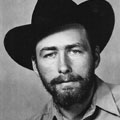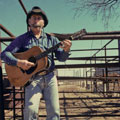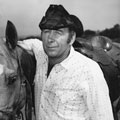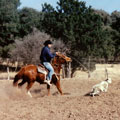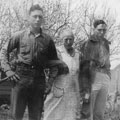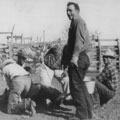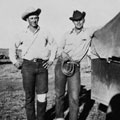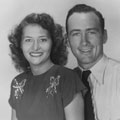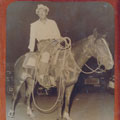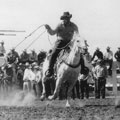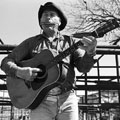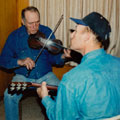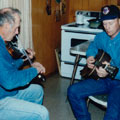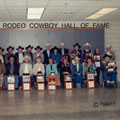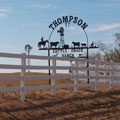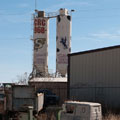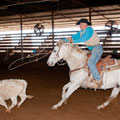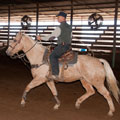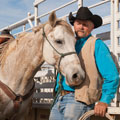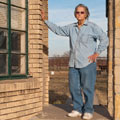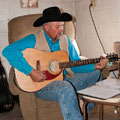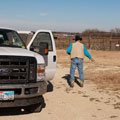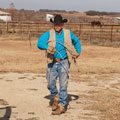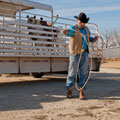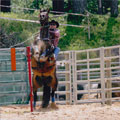John Burrus
Cowboy musician from Stephenville, TX
Media
Gwen Burrus answers the question "How old was John Burrus when he started riding horses?" Phone interview with Alan Govenar, 2010.
Gwen Burrus answers the question "Did John Burrus play Sunday mornings at the rodeos?" Phone interview with Alan Govenar, 2010.
Jamie Burrus answers the question "What is John Burrus's legacy?" Interview with Alan Govenar. Recorded by Alan Govenar. Stephenville, Texas, 2010
Jamie Burrus answers the question "When John Burrus performed for cowboys, what was his reception?" Interview with Alan Govenar. Recorded by Alan Govenar. Stephenville, Texas, 2010
John Burrus. 'He Was Just A Lonely Cowboy.' Cowboy Songs & Country Hymns. Documentary Arts CD 1010. Order from www.documentaryarts.org.
John Burrus. ''There Is Power In The Blood.' Cowboy Songs & Country Hymns. Documentary Arts CD 1010. Order from www.documentaryarts.org.
John Burrus. 'Trail To Mexico.' Cowboy Songs & Country Hymns. Documentary Arts CD 1010. Order from www.documentaryarts.org.
John Burrus. 'Windy Bill.' Cowboy Songs & Country Hymns. Documentary Arts CD 1010. Order from www.documentaryarts.org.
Jamie Burrus. "Cajun Baby (Jesus Version)." Recorded by Alan Govenar. Stephenville, Texas, 2010.
Jamie Burrus. "Cross the Brazos at Bunger." Recorded by Alan Govenar. Stephenville, Texas, 2010.
Jamie Burrus. "Sit Up Joe." Recorded by Alan Govenar. Stephenville, Texas, 2010.
Jamie Burrus. "Strawberry Roan." Recorded by Alan Govenar. Stephenville, Texas, 2010.
Jamie Burrus. "The Branded Man." Recorded by Alan Govenar. Stephenville, Texas, 2010.
Jamie Burrus. "What a Day That Will Be." Recorded by Alan Govenar. Stephenville, Texas, 2010.
FOR THE TEACHER
Introduction
In the American West, the long hours and solitary work of cowboys nurtured the growth of rich song and poetry traditions that melded elements of Anglo, Spanish, Mexican, and African American cultures. Cowboy songs are an expression of a shared experience of the men who trained horses, herded livestock, and worked the cattle drives. They contain numerous geographical references and unique occupational terms that evoke historical events and personal experiences. The music often takes a ballad form, and the lyrics can be dramatic, comic, or moralistic, sometimes including religious themes.
John Burrus’s story and songs allow students to hear traditional cowboy songs and country hymns firsthand from a working cowboy who also traveled the rodeo circuit to compete. His real-life cowboy experience always included music. Given his first colt, he traded it for a mandolin!
John Burrus is a springboard for ongoing discussions about where students encounter, enjoy, and participate in music in their own lives and the myths and realities of the cowboy.
Objectives
Students may:
- Improve listening skills and note taking
- Research the history and occupational culture of cowboys
- Investigate cowboy songs as part of history
- Learn a traditional cowboy song
- Examine the myths and realities of cowboys
- Explore the landscape of West Texas
- Learn about cowboy poetry
- Consider Anglo, Spanish, Mexican, and African American influences on cowboy culture and music
- Compare the work of cowboys with that of another occupation
Big Ideas
Occupational Culture
- Occupations are vital folk groups, or subcultures, with distinctive skills, terms, clothing, gear, tools, jokes, techniques, work spaces, hierarchies, beliefs, and customs.
- The occupation of cowboy reflects contributions from varied cultural groups, including British, Spanish, Mexican, African American, and Native American.
- Researching the cowboy as an occupation broadens understanding of cultural dynamics across time and place and of occupations as a cultural marker in a community or region.
Landscape and Culture
- Landscape and geography influence culture significantly.
- West Texas was ideal for cattle ranching, which required highly skilled workers and horses—the cowboy.
- Traditional songs often include references to geography, landscape, and climate and can serve as primary documents in the study of a region.
Music and Song in Daily Life
- We encounter music and song in myriad ways in our daily lives, often without noticing, and music is an important element of our personal folklore.
- The line between sacred and secular music in daily life is not always clearly drawn.
- Examining music and song in a person’s life can reveal important historic and cultural evidence.
Myths and Realities of the Cowboy
- From early cowboy movies to TV westerns and mass market advertising, the cowboy is an American icon.
- Decoding the myths and realities of this powerful symbol can reveal underlying assumptions, beliefs, and values about the United States.
- Contrary to the common stereotype of cowboys being like John Wayne, diverse cultural groups contributed to the occupation of cowboys. In fact, cowboys still work today from Canada to Argentina, Hungary to Mongolia—not just in the United States.
Materials
John Burrus’s story and photos
Radio
clip
Music
clips
Everyday Music Field Notes
Traditions
Venn Diagram
Time Required
1-2 class periods
Subjects
Texas history, social studies, English language arts, music
Preparation
Review John Burrus’s story and the media clips. Choose Big Ideas that you find relevant to your curriculum and your students. Copy Everyday Music Field Notes and other worksheets students will need and cue the audio clips.
Class Discussion
Students may read the story and listen to the audio story independently, in groups, or as a class. Using the Everyday Music Field Notes worksheet will help them focus more closely. In a class discussion, raise some of the Big Ideas above, depending upon your curriculum and students’ needs and grade level. Here are questions to spark discussion:
- Do you have family members who have lived on ranches in the past or today? What can you share about the real-life work of ranch families?
- How does the work of today’s cowboy compare with the work of cowboys of other eras?
- How do cowboys in movies compare with working cowboys?
- Why do you think the cowboy is such a powerful symbol not only of Texas but also of the United States?
- How does the story of John Burrus compare with your ideas about cowboys?
- What surprises you about cowboy songs?
- Why does John Burrus call the harmonica the ideal cowboy instrument?
- John Burrus learned cowboy songs from family and neighbors during his childhood as well as from songbooks. How do you learn songs?
- Old hymns as well as cowboy songs were part of John Burrus’s repertoire, blending sacred and secular. Are there times when the sacred and the secular blend in your life?
Suggested Activities
Students may work independently or collaboratively to:
Research the diverse origins of the cowboy and cowboy culture. Be sure to include language, terms, music, poetry, gear, living conditions, trail rides, ranch life, etc. Use songs by John Burrus to help tell the story of your findings in a class presentation.
Listen carefully to John Burrus sing “Zebra Dun,” a popular cowboy song dating to the late 19th century. It is a ballad about a stranger who is given a tricky horse to ride. Listen for the exaggerated language and special occupational terms. For example, a zebra dun is a light-colored horse with dark streaks and a dark mane and tail. Choose stanzas to memorize and recite like poetry for a class presentation that you may illustrate with a storyboard of the song’s action.
Choose a cowboy song and learn the lyrics and melody to sing in a classroom concert or podcast. Extra points for researching and reporting on the song’s origins and tune! Good examples that John Burros sings include “Windy Bill,” “Trail to Mexico,” “Bury Me Not on the Lone Prairie,” “Cool Water,” and “The Streets of Laredo.”
Research local and regional rodeos, including types of contests, roles of various age groups and men and women, sequence of events, prizes, advertising, and music (see Resources). Share findings in an oral report, illustrated essay, or Web page.
Investigate cowboy poetry and poetry gatherings, which feature cowboy music as well as poetry. The Western Folklife Center website features audio and video clips of poetry and songs from the annual National Cowboy Poetry Gathering and radio programs (see Resources). Use this website and other resources to identify poems and songs to learn. Organize a cowboy song and poetry gathering in the classroom. Be sure to record it.
Interview family members about their concepts about cowboys. If possible, invite someone who has lived on a ranch or participated in a rodeo for a classroom interview. What values do interviewees think cowboys represent? What do they say about Texas history? Be sure to use a Release Form. Write an essay or cowboy song lyrics summarizing the interview.
Research the landscape and geography of West Texas and how it contributed to the development of the cattle industry as well as the occupation and culture of cowboys. Share results, including maps, a timeline, and music in a class presentation.
How many students would like to be a working cowboy? Use the Traditions Venn Diagram to compare the work of a cowboy with that of another occupation and share reflections in a class discussion.
Both cowboy songs and Mexican American corridos include ballads, which are songs that tell a story. Compare “Zebra Dun” by John Burrus with “Mal Hombre” by Lydia Mendoza. Use the Traditions Venn Diagram to illustrate how cowboy ballads and corridos differ and are similar. Share results in a class discussion.
Assessment Strategies
Discussions
Field
notes
Presentations
Recitations
Storyboards
Songs
Poems
Reports
Maps
Timelines
Web
pages
Podcasts
Interviews
Venn
diagrams
Vocabulary
ballad
cowboy
cowboy
poetry
cowboy
songs
guitar
harmonica
occupational
culture
rodeo
Standards
Analyze information
Use
and create primary sources
Development
of the cattle industry, agriculture of West Texas
Myths
and realities of the cowboy
Thematic
maps
Humans
and the environment
Spanish
influence on language and culture
Resources
Websites
Louisiana Voices Unit VIII The Worlds of Work and Play www.louisianavoices.org/Unit8/edu_unit8.html
Professional Rodeo Cowboys Association www.prorodeo.com
Texas Rodeo Cowboy Hall of Fame, Ft. Worth www.texasrodeocowboy.com
Western Folklife Center, Elko, Nevada www.westernfolklife.org
Recordings
John Burrus. Cowboy Songs & Country Hymns. Documentary Arts CD 1010. Order from www.documentaryarts.org.
Buck Ramsey. Hittin’ the Trail. Smithsonian Folkways SFW50002. Order from www.folkways.si.edu.
Various Artists. Cowboy Songs on Folkways. Smithsonian Folkways SFW40043. Order from www.folkways.si.edu.
Films
Cowboy Poets. Directed by Kim Shelton, 53 min., 1988. View online at www.folkstreams.net. A fourteen-minute excerpt and learning guide are featured on the Educators Portal.
The Hard Ride: Black Cowboys at the Circle 6 Ranch. Directed by Alan Govenar, 27 min., 1996. Order from Amazon.
Texas Style. Directed by Alan Govenar and Pacho Lane, 28 min., 1985. View online at www.folkstreams.net/film,163. Also available on DVD from www.documentaryarts.org.
Why the Cowboy Sings. Directed by Hal Cannon and Taki Telonidis, 58 min., 2002. Order from www.westernfolklife.org.
